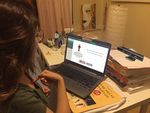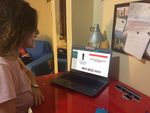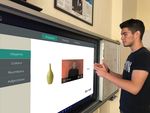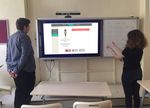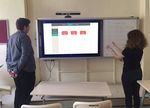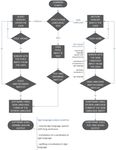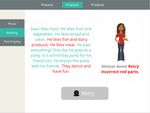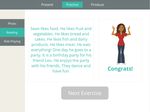Enhanced English Language Learning Experience for Deaf and Hearing Impaired People - Täiustatud õppimismeetod kurtidele ja kuulmispuudega inimestele
←
→
Page content transcription
If your browser does not render page correctly, please read the page content below
Msc. Design & Engineering
Department of Machinery
MED70LT
Enhanced English Language
Learning Experience for Deaf and
Hearing Impaired People
Täiustatud õppimismeetod kurtidele ja kuulmispuudega inimestele
Neriman Aslı Atalay
TALLINN 2018Author’s Declaration Hereby I declare, that I have written this thesis independently. No academic degree has been applied for based on this material. All works, major viewpoints and data of the other authors used in this thesis have been referenced. ‘......’ ........... 2018 Author ....................................... signature Master’s thesis is in accordance with terms and requirements ‘......’ ........... 2018 ‘......’ ........... 2018 Supervisor ................................... signature Accepted for defense .............................................................. chairman of defense commission. ‘......’ ........... 2018 ............................ signature
Master’s Thesis Objective & Task 2017/2018 academic year, Spring semester Student: Neriman Asli Atalay, 156291MADM Field of study: Design & Engineering Supervisor: Ruth-Helene Melioranski Master’s Thesis Topic: Enhanced English language learning experience for Deaf and Hearing-Impaired People Tasks and timeframe for their completion: Nr. Task description Completion date 1 Discover: Literature Research 10.02.2018 2 Discover: User Research in Tallinn Helen’s School 20.02.2018 3 Define: Presenting insights and user needs 17.03.2018 4 Develop: Conceptual development process 21.04.2018 5 Deliver: Finalizing Master’s Thesis 20.05.2018 Defence application submitted to deanery not later than 28.05.2018 Deadline Student: Neriman Asli Atalay .............................. Date: Phone: +372 5199 0559 Email: atalaynasli@gmail.com Supervisor: Ruth-Helene Melioranski .............................. Date: Phone: +372 5660 3440 Email: ruth.melioranski@artun.ee
Abstract Deaf and Hearing-Impaired people need a special education program to learn a language since they are special linguistically, culturally and socially. Unfortunately, they face several difficulties during their language learning journey. In this thesis, bilingual education approach that respects to Deaf culture and Sign Language by welcoming and celebrating its unique features and diversity has been focused. The aim was to explore the hidden needs of Deaf and Hearing-Impaired people in their language education so that a meaningful solution could be developed by utilizing potential future technologies.
Table of Contents
Abbraviations 9
1. Introduction 11
1.1 Inspiration 11
1.2 Scope and Aim 12
2. Methodology 13
2.1 Double Diamond Model 13
3. Discover 17
3.1 Literature Review 17
3.2 User Research 26
4. Define 37
4.1 Persona Creation 37
4.2 Issue Map 38
4.3 Insights 40
4.4 Needs 40
5. Brief 43
6. Development 45
6.1 Concept Ideas Generation 45
6.2 Concept Evaluation 46
6.3 Concept Selection 48
6.4 Requirements of the Tool 497. Deliver 51
7.1 Final Concept 51
7.2 User Scenarios 69
8. Conclusion 75
8.1 Summary 75
8.2 Outcome 76
8.3 Further Development 76
References 78
Figure List 81Abbraviations
ASL: American Sign Language
BSL: British Sign Language
DHI: Deaf and Hearing Impaired
ESL: Estonian Sign Language
HI: Hearing Impaired
L1: First language
L2: Second language
91. Introduction
1.1 Inspiration
The story of Helen Keller’s life has been an inspiration to focus on language educa-
tion of Deaf people in my thesis. Helen Keller had been affected by an illness that left
her blind and deaf when she was 19 months old. She had terrible temper tantrums
during her childhood since the need of some means of communication became so
urgent.
Helen said that the most important day in her all life was the day her teacher, Anne
Mansfield Sullivan, joined Helen’s life to teach her how to communicate by spelling
words on her hand. One day, Anne took Helen outside to the pump and ran water
over her hands while spelling out the word w a t e r simultaneously. During that
magical time Helen build the relationship with the objects and their own words.She
described that moment: “I knew then that “w-a-t-e-r” meant the wonderful cool
something that was flowing over my hand. That living word awakened my soul, gave
it light, hope, joy, set it free! There were barriers still, it is true, but barriers that could
in time be swept away.”
She used that special language as a mean of communication, learning and devel-
opment. She succeeded to get a Bachelor of Art degree with honor. Moreover, she
became an educator, author, and an advocate for the blind and the Deaf people
throughout the world.
Her story motivated me to think about how language access and education is cru-
cial for people with special needs and how new technological improvements in the
world could be utilized for their education.
111.2 Scope and Aim
Deaf and hearing-impaired people need a special education program to learn a lan-
guage since they are special linguistically, culturally and socially. Unfortunately, they
face several difficulties during their language learning journey.
In this thesis, I focused on bilingual education approach that respects to Deaf culture
and Sign language by welcoming and celebrating its unique features and diversity.
Additionally, I narrowed down the topic to English language education (as a foreign
language) of Deaf and hearing-Impaired people. Those focus areas have supported
to form my research questions.
Main research question: How can I support language learning process of Deaf and
hearing-impaired people?
Sub questions:
• How do Deaf or hearing-impaired people learn English (as a foreign language)
via bilingualism education approach?
• Why do they have difficulties during that learning journey?
• How can Kinect technology support their education?
The aim of this thesis was to find out how can the bilingual English language ed-
ucation (as a foreign language) of Deaf students be supported by utilizing Kinect
technology.
122. Methodology
This section explains the processes, methods and tools used in this thesis as well
as why they were suitable in the current circumstances to ensure the best results.
Double Diamond model developed by British Design Council in 2015 is used as a
design process methodology in this thesis. The model consists of 4 main phases:
Discover, Define, Develop and Deliver. Each phase requires to utilize different meth-
ods and tools.
2.1 Double Diamond Model
Figure 2.1 Double Diamond Diagram. Source: British Design Council.
Double diamond model graphic represents that both divergent and convergent
thinking are used twice, first to find a real need and then to find a solution satisfying
that need.
132.1.1 Discover
Discover phase is the beginning of the project in which more information about
the initial problem and related topics to it are gathered through the research. New
things are learnt as well as insights are gained.
In this thesis; literature research, in depth interviews and observations were done
under discover phase. Literature research helped me to be more confident about
bilingual education of Deaf and hearing-impaired people. Additionally, a suitable
technology was found out to be utilized. In depth interviews were conducted with an
expert in the field to ask how and why questions to discover how theoretical knowl-
edge is applied in practice. Thanks to the interviews insights were gained about the
subject and new terminologies were learnt which triggered me to do more literature
research for more narrowed down topics. Observation done as a research method
supported me to gain more insights about the main characters of the research.
Observation was quite beneficial since the users’ behaviors could be watched and
analyzed at their environments.
2.1.2 Define
Output of the discover phase is analyzed and evaluated in define phase to describe
the most meaningful insights. A clear design brief should be defined in the end of
this phase.
User research done in discover phase inspired me to create user personas to define
the most meaningful user issues and problems. Creating a persona, who is a fiction-
al character reflecting different behaviors of the users, is one of the user centered
design thinking methods. It helped me to define users’ behaviors, problems and
needs. It is a good way to empathize with the users so that better user experi-
ences could be designed in development phase.
Issue map had been created in which user personas were classified based on their
characteristic features and problems. It supported me to define the user needs
14clearly. After the user needs were defined clearly a design brief, which is a guidance
for development phase, was created.
2.1.3 Develop
Possible solution ideas are generated in develop phase. Ideas are evaluated, elimi-
nated and selected with a critical approach.
Three different concept ideas were generated in this phase via brainstorming. They
were evaluated via concept evaluation matrix by considering the defined needs of
the users. In the end, all concept ideas were combined in one new concept which
was chosen as a final output. Furthermore, technological and functional require-
ments were listed.
2.1.4 Deliver
British Design Council says that delivery phase, which is the final quarter of the dou-
ble diamond model, results in producing and launching the project with an output of
a product, service or environment.
In this thesis, digital prototype was presented and used in different user stories to
deliver the final concept idea. The purpose of delivery here was not producing and
launching the final product. Concept prototyping was the way of explaining the
solution to the potential users and stakeholders to get their feedbacks so that the
concept solution idea could be criticized and developed further.
1516
3. Discover
3.1 Literature Review
3.1.1 Bilingualism of Deaf People
Deaf people who know and use both a sign language and spoken language are
bilingual individuals. (Baker & Baker, 1997)
Deaf bilinguals have at least two languages and three modalities (signing, writing,
speaking) (Maxwell, 1996). Sign language brings signs while a spoken language
brings writing and speaking as a modality. Maxwell says that the recognition of
American sign language let hearing people to see Deaf people as bilinguals (the
ones who know a spoken language and a sign language), competent and inventive
(1996).
Knowing a sign language and a spoken language is more specifically called as bi-
modal (speech sign) bilingualism thus people who know at least one sign language
and one spoken language are called as bimodal bilinguals. Bimodal bilinguals could
be Deaf people, hearing children of Deaf parents, hearing parents of Deaf children
or hearing people who learnt a sign language etc.
Simultaneous nature of bimodal bilingualism: Code Blending
Bimodal bilinguals have a unique communication situation in which two languages
can be perceived or produced simultaneously since the sign and spoken languag-
es have different perception and output channels. A spoken language perceived
auditorily and produced via the vocal tract. On the other hand, a sign language is
perceived visually and produced via hands. (Emmorey, Borinstein, Thompson, Gol-
lan, 2005)
17As a result of main difference between a sign language and a spoken language,
which is the way of reception and production of the language, bimodal bilinguals
can produce speech and sign expressions at the same time. This unique way of
communication is called as code blending in bimodal bilingualism. Vision and hands
are used in a sign language while audio and voice are used in a spoken/written lan-
guage for reception and production. Therefore, using both channels simultaneously
is possible. That explains the unique nature of code blending in bimodal bilingual-
ism which does not belong to other bilingualism productions. Other bilingualism
methods are not able to use code blending, they must switch from one language
to another to use both languages. For instance; two spoken languages cannot be
produced at the same time by one person, the person must switch from one lan-
guage to another one. Switching from one language to another one is termed as
code-switch in bilingualism. (Emmorey, Borinstein, Thompson, 2005)
3.1.2 Bilingual Education of Deaf People
Bilingual education of Deaf people that uses both a sign language and a spoken/
written language is an approach developed in 1980s in Scandinavia, the USA and
the UK (Swanwick, 2015).
This approach has been developed as a result of dissatisfactions of oral education
approach. There are different studies from different countries explaining the poor
results of oral education approach (Gregory, Hindley 1996). For instance, the study
of Conrad published in 1979, showed that the Deaf students who were specifically
educated through oral education approach had not improved their speech and lip
reading skills as much as it had been expected since their speaking levels were poor
and lip reading skill levels were not better than the hearing people’s levels when they
had left the school. Furthermore, Gregory, Bishop and Sheldon also found out that
there were Deaf people who educated via oral education model and they had not
gained sufficient linguistic skills to be able to communicate in an interview (1995).
Sweden is the first country in the world who recognized a sign language as a lan-
guage of Deaf people in 1981 and created a law stating that people who are Deaf
18should be bilinguals to understand their families, friends and the world better and
deeper. Sweden not only recognized the Swedish sign language but also in 1983
implemented bilingual education approach in the education of Deaf students. In
schools, where Deaf students get education, bilingual approach has been decided
to be used which means Swedish sign language which accepted as a first language
of the students is used as a media of instruction together with Swedish language.
(Svartholm, 2010)
3.1.3 Language Education of Deaf People
Marschark’s research synthesis, containing approximately 180 references, conduct-
ed in 2001 about language development in children who are deaf found out:
• Deaf children access language learning later than hearing people.
• They have less suitable and sustainable language education programs than
hearing people.
• When Deaf children learn sign language as preschoolers their academic and
social success during their school years got increased.
• Combining sign and spoken languages in Deaf children education models may
provide more efficient education than using only one language.
• Bilingual education of Deaf children should be considered as a complementary
strategy rather than mutually exclusive alternatives because using both a sign
and spoken language in Deaf children language education motivates their lan-
guage developments.
3.1.4 English Education as a Foreign Language for Deaf or
Hearing Impaired People
Importance of bilingual approach in deaf students’ education is clear. Moreover,
teaching foreign languages, especially English to deaf or hearing impaired students
plays a significant role in their lives since learning English as a foreign language
enable deaf people to get many opportunities because of its common usage area.
(Zyśk and Kontra, 2016)
19According to a survey done about Europeans and their languages, English is the
most common foreign language learnt in Europe. Furthermore, two thirds of Euro-
peans think English as one of the two most useful languages for themselves and
79% think that learning English for next generations is quite beneficial. (Special
Eurobarometer 386, 2012) Therefore, there are educational, professional or per-
sonal reasons of learning English and deaf or hard of hearing people have a right to
access and learn English language as a foreign language and as equal as hearing
people. (Zyśk, 2015)
3.1.5 Foreign Language Teaching Methods
Under this topic, foreign language teaching methods were reviewed, and the most
common methods were chosen to be explained.
3.1.5.1 Grammar-translation method
Language teaching via grammar-translation method gives importance to the gram-
mar rules since the core element of teaching is grammatical analysis, morphology
and syntax. Moreover, the most significant type of practice is the translation. Teach-
er gives the grammar rules and vocabularies and translate them by using L1. Stu-
dents should memories the grammar rules and vocabulary to show that they learn
so they are drilled over and over to memories the given grammar rules and vocab-
ularies. Therefore, communication in L2 is not the outcome of the course. Outcome
could be written exercises, memorizing vocabulary or translation of texts. (Molina,
Canado, Agulló , 2015)
Vocabulary word list, which has one column of words written in L2 and another col-
umn of the same words written in L1, is used as a course material. It is clear that the
teaching and learning focus on memorizing rules and translating texts. However, the
speaking and communicating skills of the students are not developed.
203.1.5.2 Direct method
As a result of the increased criticisms and dissatisfaction of grammar translation
method, direct method is developed to teach the new language for using it in every-
day life as a mean of communication.
Questions and answers are used in the teaching environment thus everyday use of
language teaching is prioritized. Grammar rules are not given in this method, stu-
dents discover the language rules during the exercises done in new language (L2).
L1 is avoided to be used so that the students can develop their communication
abilities in L2. The objective of the course to develop listening and speaking skills
in L2. Reading and writing skills are not prioritised (Molina, Canado, Agulló , 2015).
3.1.5.3 Audio lingual method
In this method, first the new language forms are heard by the students. Written
forms in L2 or in L1 are not shown even for explanation. Instead of written forms,
the visuals and records are utilized to teach. Substitution drill activities and trans-
formation drill activities are used in this method. For instance, in a substitution drill
activity, the teacher starts with a basic sentence, such as “I see a dog” and after
that the teacher shows different pictures so that the students could substitute “dog”
within different pictures. Furthermore, in a transformation drill activity, teacher says
a sentence, such as “I sing a song” and then students change the sentence into “I
don’t sing a song”(Jonathanzludwig, FluentU).
3.1.5.4 Bilingual method:
The bilingual method of foreign language teaching developed by C.J. Dodson (1967)
advocates the use of the mother language (L1) in learning a second language (L2).
Wolfgang Butzkamm states that traditional three-phase structure (presentation -
practice – production) is used in bilingual foreign language teaching method:
Present Phase:
Language teaching starts with the presentation phase when the new subject is pre-
sented to the students by the teacher.
21New subject (which could be new vocabularies or grammar knowledge) can be
presented via imitation of a dialog in L2. Visuals like photos and audial written form
of the dialogue in L2 are used. Then the new subject is interpreted thanks to L1.
Practice Phase:
After that, students do exercises under practice phase by using the new words,
structures or phrases they learnt. Teacher’s control exists in this phase since the
knowledge of the students is checked by the teacher via practices done in L2. L1 is
also used to interpret and translate when needed. (Criado, R. 2013)
The activities are chosen and developed by the teacher. Students are expected to
expand their new knowledge by forming new combinations. For instance, the new
vocabularies learnt in a specific dialog in the first phase are used in different kinds of
dialogue cases in practice phase. Moreover, new grammar structures learnt in the
presentation phase can be combined with different vocabularies or communication
contexts. Substitutions and extensions of the new knowledge are created via teach-
er developed exercises. (Alexander & Butzkamm, 1983).
Production Phase:
In the end, there is a production phase where students can speak, write or have a
dialogue in L2.
Students create original role-playing scenarios by doing independent sentence con-
struction and expression. Then, they do interpretations and translations of what
they build via using both L1 and L2. In the end of the production phase, students
are able to build questions/answers in L2 which means that they have a natural
conversation in L2.
There is a possibility that students are not skilled up yet to be able to communicate
independently in L2 during the early steps of each phase. Therefore; L1 is used to
explain the new materials and exercises so that the students can be aware of the
meanings to acquire the language knowledge better. Moreover, in the end of the
learning process, especially in the last steps of production phase, L2 is used as a
22meaning of communication to create natural communication outputs like speaking
and writing. It is claimed that using mother language as a tool rather than an end is
a creative use of languages and it makes the bilingual language education method
successful in many classes (Alexander & Butzkamm, 1983).
3.1.5.5 Communicative method
Communicative teaching method is developed as a reaction to the previous meth-
ods. It has three basic principles. Thanks to those principles, language education
become more rational, interesting and relevant to students’ needs.
1. Real communication cases are used in class activities.
2. Activities include meaningful tasks for the students. Activities are chosen based
on students’ interests and needs.
3. Teaching and learning process is supported by a meaningful language for the
students.
There are different activities could be done via this approach. Comparing pictures,
problem solving, analyzing a map, having conversations and dialogues, role-play-
ings are some activities utilized in communicative method. Activities are done via
materials taken from real life such as newspapers, magazines, restaurant menus,
maps. Text book exercises are used as well.
The communicative method supports learner-centered teaching. Main roles are
taken by the students during the activities. Teacher’s role is to guide and assists
students while they do contribute to the classroom by negotiating, interacting and
cooperating. (Molina, Canado, Agulló, 2015)
3.1.6 Kinect Technology
Kinect technology is designed and developed by Microsoft originally for gaming.
Kinect has audio and movement sensors. User’s physical position and movements
23are perceived by Kinect sensors and Kinect translate this data into commands
thanks to computer.
Although Kinect’s main purpose is game industry Kinect’s features are used for dif-
ferent areas via different applications from surgery to virtual fitting rooms.
‘’Stewart Tansley of Microsoft Research, Tim Pan of Microsoft Research Asia, and
Professor Xilin Chen of the Chinese Academy of Sciences have worked together to
develop yet another great application of Kinect: the ability to bridge the deaf and
the hearing worlds through sign language recognition.’’ (Microsoft Research, 2013)
Chinese Academy of Sciences, Beijing Union University and Microsoft Research
have been working on development of Kinect technology for deaf people by aiming
to create a software which transform a sign language into spoken language and
vice versa. That means that deaf people and hearing people who do not know any
sign language would have a conversation in real time with the help of Kinect sign
language translator. Communication barrier between deaf and hearing people will
be destroyed thanks to that technology. Kinect’s sensors will capture the audio or
signs and transform them into other form. Hearing person’s spoken language will be
taken by Kinect audio sensors and the software will translate that spoken language
into sign language with the help of an avatar in the software and that will happen
in real time. Meanwhile, the deaf person will be able to understand what the hear-
ing person was saying and will give an answer in sign language. Signs of that deaf
person will be gestured by Kinect’s movement sensors and software will translate
the sign language into written or audio form of the spoken language. As it is under-
stood, hearing people and deaf people will have the opportunity to communicate in
real time. This will enable deaf people to contribute to the hearing society more than
ever and vice versa.
The purpose is to develop Kinect with machine learning so that the sensors and
computer will be able to understand the gestures of a sign language and transform
the sign language into audio and text, and vice versa. Machine learning technology
and pattern recognition technology are combined to create a meaning for a real
24need of deaf community. Currently they included American Sign and Chinese Sign
languages into the system, they are on the progress of increasing the richness of
vocabulary and language repertoires.
Director of Microsoft Research, Stewart Tinsley said ‘’You can communicate be-
tween American sign language and Chinese Sign language—or potentially any Sign
languages to any other natural language.’’
Kinect translator technology is in the prototyping phase which will bring about many
benefits for Deaf society when it is completed and succeeded to be in the market.
It will create personal benefits for individual deaf people and also it will provide new
job opportunities for Deaf society. Microsoft research showed Kinect translator’s
benefits via different scenarios. For instance; a Deaf person visits a physician who
does not know any sign language and Kinect translator supports their communica-
tion process thus there is nothing else needed. Deaf person can communicate via
her/him natural sign language and the physician understand her/him thanks to Ki-
nect translator. On the other hand, the physician talks in her spoken language which
is English and Kinect translator translate audio into sign language via its avatar.
Another scenario they provided is in the airport at information desk: Deaf person is
working at the information desk with the support of Kinect translator. When hearing
people ask any question Kinect would translate it into Sign language. Deaf person
will answer the question in Sign language. Then, Kinect will translate the Sign lan-
guage into spoken language that the hearing person had spoken.
Kinect translator would create meanings for real needs in many areas. In this the-
sis, I have discovered the needs of the Deaf society in language education. Those
needs has been explained in the next chapters in detail. I strongly believe that Kinect
translator would create a significant benefit in the learning process of Deaf people if
it is applied in a solution which is designed with human centered approach.
253.2 User Research
The user research was done cooperating with Tallinn Helen’s School.
3.2.1 General Information about Tallinn Helen’s School
Tallinn Helen’s School, which was named as Tallinn School for the Deaf until 2005,
is a municipal school founded in 1994 on the initiative of the parents of Deaf chil-
dren where students with sensory impairment (visual and hearing impairment) and
speech impairment are taught from kindergarten to basic school. The students have
the opportunity to fulfil their developmental potential and obtain education accord-
ing to their abilities in a safe, modern environment that meets their special edu-
cational needs. The school has been in constant development. In 2005, classes
were opened for visually impaired students in kindergarten and school. In 2014, the
school opened the doors to students with speech impairment.
Department A (students with hearing impairment)
Sign language users with hearing loss over 40dB and/or students who need sign
language support in their studies (including those with hearing aids or cochlear im-
plant) are registered in Department A. Estonian Sign Language and Estonian are the
languages of instruction in Department A.
Study environment in Department A
Visualized learning with support of a computer, data projector and document cam-
era plays a significant role in Department A. Since hearing sense is unavailable
learning is triggered via visual associations.
Teaching is provided in Estonian Sign Language (ESL) and Estonian which are first
and second languages of the students. ESL is the students’ first language and Es-
tonian language is their second language.
26Language teaching
Learning a language is a way of communication and a tool to learn different study
fields like Math, History etc. Therefore, language teaching is significant in Tallinn
Helen’s School. L1-Estonian sign language, L2-Estonian and L3-English are taught
during the study period.
L1 – Estonian Sign Language: Estonian sign language is the first language of
those students in Tallinn Helen School. Teaching starts in Year 1.
Ability to use ESL in real life situations, expressive signing, deaf culture in Estonia
and other countries are taught. Students learn about historical and current famous
Deaf figures.
ESL fingerspelling:
Figure 3.1: ESL fingerspelling. Source: http://www.eki.ee/dict/viibex/
Foreign language A – Estonian Language: Estonian language is the foreign lan-
guage A and its teaching starts in Year 1.
Foreign language B – English: English language, which is the second foreign lan-
guage, teaching starts in Year 5.
273.2.2 User Research Methodology
How English language education is provided to deaf students in Tallinn Helen school
was the main question in the beginning of the user research. Acquired knowledge
from the literature research shaped the user research questions at first. It was quite
interesting to research how theoretical knowledge is applied in Tallinn Helen’s School
in bilingual education of Deaf students.
Firstly, research methodologies were reviewed to choose the most appropriate ones
to this research field.
In depth interviews enable researcher to ask how and why questions to discover
the research field deeply. On the other hand, via observation method there is an
opportunity to analyze the process and situation in real time so that the researcher
can find answers by watching the main characters. Therefore; the best way to get
a clear understanding of the learning process was to conduct in-depth interviews
and observations.
3.2.2.1 In-depth interview
Two interviews were conducted with English teacher Kadri Hein-Loik. Interview
questions were prepared based on the literature research findings to understand
how theory is implemented in practice. How and why questions are prepared under
the main research question. Nature of the interview allowed me to ask additional
questions that came up as a result of Loik’s answers.
First interview was face to face, during that time new terminologies regarding bi-
modal bilingualism had been learnt and then more literature research was done.
User research triggered more literature research to be done and vice versa.
After the first interview and more literature research, more specific questions have
been prepared in a written form and answers were provided by Loik in a written
form.
283.2.2.2 Observation
Three English classes were observed.
Each class had diverse English language levels of students based on hearing level
and age.
First observation was done in a class consisting of two students. One was deaf and
the other one was speech impaired.
Second observation was done in a class consisting of 5 female students and 2 male
students who are at the age of 15-17. Their level of hearing loss differs.
Third observation was done in a class consisting of 4 students who are at the age
of 9-12. Their level of hearing loss differs.
Literature research and two in-depth interviews done with Loik made me aware of
what to look for and analyze during the observation.
3.2.3 User Research Findings – Teaching and Learning Process
Under this topic, how deaf students in Tallinn Helen School learn English via bimodal
bilingualism methodology was explained.
In Tallinn Helen’s School Department, A (department for hearing impaired students)
bilingual approach for teaching is used. Students’ first language is Estonian Sign
Language (ESL) and second language is Estonian. Both languages are used in ed-
ucation of the students as Bilingual approach suggests.
Bilingual method of foreign language teaching is partly used by Kadri Hein Loik who
is the English teacher in Tallinn Helen School. She said that she gives importance to
Estonian Sign Language and Deaf culture. In the description of bilingual method, it
is said that the teacher mostly uses the L1 (first language), not the students. In her
29case, sometimes the students use Estonian Sign Language, too, such as in trans-
lating a text to their L1 (ESL).
She also relies on the Communicative method and she does some activities with the
students in the classroom by using that method. However, it cannot be said that the
approach is entirely communicative. She tries to use as much English in the lesson
as possible, but sometimes she gives theoretical explanations in ESL, that is, the
students’ L1, as needed.
She mostly teaches the written form of English, but students learn to say important
words and expressions, such as “Hello”, “My name is…”, “I am Deaf.” Some stu-
dents successfully participate in spoken dialogues and recite poems.
Students also learn the basics of British Sign Language (BSL), just for giving them
experience of sign language used in an English-speaking country, mostly done at
the end of the term. For example, they have learned how to fingerspell their name in
BSL, meet and greet, and they have signed Christmas songs in BSL.
3.2.3.1 Presentation Phase:
Vocabulary Presentation:
At the beginning of a Unit, first the teacher signs and speak vocabulary to explain
the required words in the unit. Sometimes she signs herself; sometimes she uses
sign language dictionary: www.spreadthesign.com to present the English vocab-
ularies in Estonian sign language. Then students sign (and speak, depending on
students) and write down the most important words of this Unit in English and Es-
tonian. Some students who are willing to increase their speaking skills pronounce
the words as well.
Presentation phase is supported with visualizations. For example, vocabularies are
shown also as pictures found from internet.
Longer text or dialogues presentations:
For longer text or dialogues, students read the paragraphs while the teacher signs
30it at the same time. They also do practices with the same method; students read
the paragraph and sign it, sentence by sentence, to show that they understood the
presented content.
As it is understood ESL is used to explain the meanings of vocabulary or to explain
the subjects in the lecture. Moreover; ESL is also used to understand if students are
really understanding the English vocabularies or text and dialogues. For instance,
students read a paragraph in English and sign it as parallel in ESL so that the teach-
er can check if they understand it or not.
3.2.3.2 Practice Phase:
In the practice phase students consolidate what they learned via practices done in
classroom or home exercises.
They do some exercises, such as matching vocabulary items in English and Esto-
nian or a gap-filling exercise in the textbook/workbook; they also use existing/self-
made apps to practice English.
Examples of practices done using communicative and bimodal bilingual approach:
• Role-plays (e.g. learning to order from a menu in English): Students do role-
plays in different scenarios. For instance; they do roleplaying exercise in a res-
taurant concept. One student plays the role of a waiter and the other one plays
a role of a customer. In this context, customer student orders lunch from a menu
in English and the waiter student answers the customer in English. They have
a dialogue in English. There are different ways to do it. They can read the exist-
ence dialogue and sign it which is a reading practice. Or they can made up their
speech and write it to have a writing exercise. Some students would prefer to
read their text and then speak it instead of signing while others only read, sign
and write.
• Reading the text in chorus
31• Signing the text in Estonian Sign Language: This exercise is observed during the
observation, it was a common exercise done in all classes observed. Students
read the text and sign it in Estonian sign language during this exercise.
• Acting out the situation in speech/writing
• Acting out some similar situations in speech/writing interactive tasks using a
tablet (such as visiting an exhibition and finding information about it in English)
• Using a computer (they practice tasks in English “copy, paste, delete”, etc.)
• pair work, group work
• giving and receiving instructions based on an authentic city/underground map
• e-pals, pen friends
• filling out forms
• games (such as board games, Story Cubes, card games with QR codes – find-
ing information about the sights in Estonia; spot the differences)
This exercise is observed in the third class where there were 4 students at the age of
9-12. The students played a board game to match the English words with pictures
on the cards.
• Videos with English subtitles, authentic newspaper articles, brochures.
• She has also invited native speakers of English to the lesson to talk to students.
3.2.3.3 Production phase:
In production phase, students combine what they learned during different lectures
and they creates outcome which is usually in a written form. Examples:
• The students write a summary of the text.
• The students write dialogues or perform them orally/role-play
• The students recite a poem or write it down.
• The students write a letter.
Students become more independent in all three phases, such as making flashcards
32for themselves in Quizlet in the practice phase. The importance of production in-
creases in time. Students can write more complicated texts on their own. There are
lots of aspects that influence language use of deaf students, such as:
• Estonian Sign Language proficiency of the person they are interacting with.
• Their own sign language and spoken language proficiency.
• Hearing status of the interlocutor – whether it is a deaf, hearing, or hard of hear-
ing person.
• Their own hearing status. Students with milder hearing loss who use hearing
aids may be more willing to use spoken language.
• Parental hearing status. If a deaf student uses only Estonian Sign Language at
home with his/her deaf parents, he/she tends to prefer Estonian Sign Language
at school too.
• Context in which interaction takes place.
According to the teacher the production phase is difficult, as students may some-
times feel they do not have enough knowledge to produce long pieces of writing.
The teacher has supported them by asking to write a summary of the text first
and produce a story by heart. Later, the students can already write according to
prompts.
3.2.3.4 Homework Process
Homework is explained by the teacher in the classroom. Homework could be a
written exercise, such as gap-fill, an online exercise, a letter, presentation, etc.
3.2.3.5 Assessment Process
Students are assessed according to the assessment criteria designed in Tallinn Hel-
en’s School, which are based on the National curriculum for basic schools.
Language competences of students vary. Some students lag behind others, and
some have acquired better language skills. Language levels expected from the stu-
dents at the end of basic school are given in the national curriculum.
333.2.3.6 How do their spoken and sign language repertories/usage change
over time?
Focusing on English language development, the teacher said that students’ vocab-
ulary enlarges in time, they move from comprehension toward production. They
use grammatical structures more precisely; they become more fluent in speech and
writing. At the beginning of studies deaf students tend to use the same construction
throughout the text, e.g. “I saw a big house. I saw a man. I saw a dog.” Later on
language structures become less repetitive and more varied.
Hearing students learn accidentally: They listen to the news, watch TV in English,
but Deaf students do not have that possibility. This is one of the reasons why they
lag behind hearing students.
The teacher has noticed that deaf students who read newspapers in English and
communicate with friends from abroad benefit from it. Their vocabulary develops,
and they start using different constructions in expressing themselves.
3.2.3.7 Association between sign and written vocabularies?
New vocabularies are presented by using sign language so that the students could
understand and learn their meanings. The teacher signs new vocabulary items or
use online sign language dictionary. Sometimes she points out the differences be-
tween Estonian Sign Language, English, and Estonian.
Written language is supported by fingerspelling, which presents the written form of
the word. When asking students for words in English, the teacher usually signs the
word or shows the picture, and they say the word in English and fingerspell it. To
sum up, signing the words, fingerspelling the words and the photos help to create
the associations.
3.2.3.8 Technologies used in classroom
www.spreadthesign.com, a sign language web dictionary is used in the classroom
during presentation, practice and also production phases when needed. Also, dif-
34ferent apps designed for hearing students, such as learningapps.org, Quizizz, Ka-
hoot, padlet, etc. are used. There are also robots to learn English, such as English
Tutor Pandorabots app or https://www.tolearnenglish.com/free/celebs/alice.php.
The teacher said that she hasn’t found a free avatar that produces longer texts in
English with subtitles.
3.2.3.9 What are the advantages or disadvantages of bimodal bilingualism
in teacher’s practice?
Bimodal bilinguals in Estonia have a wide repertoire of languages: Estonian Sign
Language, Estonian, and English. They sometimes know Russian Sign Language,
ASL, BSL, and International Sign. They can communicate easily with a deaf person
from another country. Sign languages are all different, but it seems to her that deaf
people have easier access to other sign languages and Deaf communities than
hearing people have to other spoken languages.
Bimodal bilinguals have the unique ability to speak two languages at the same time
with a different word order, such as Estonian and Estonian Sign Language. There-
fore, they can theoretically produce both languages simultaneously in a correct
way. In unimodal bilingualism, such as Italian-English bilingualism, it is impossible to
speak two languages simultaneously.
The teacher has noticed that bimodal bilinguals switch quite fast and naturally be-
tween Estonian and Estonian Sign Language.
3536
4. Define
4.1 Persona Creation
Creating a persona, who is a fictional character reflecting different behaviors of the
users, is one of the user centered design thinking methods which helps to define
users’ experiences, goals and needs. It is a good way to empathize with the users,
communicate with the research insights so that better user experiences could be
designed in concept generation phase. (Ilama, 2015)
In this chapter, five personas were created thanks to the inspiration gained from the
user research. Personas helped to define the needs which directed me to clarify the
design goal.
Personas:
Ragnar: Ragnar is hearing impaired. He is social and eager to speak in English. His
classmates have lower level of hearing than him. Their focus to learn how to under-
stand and write in English. They are shy to speak in class in front of other people,
but Ragnar needs to talk to practice. Therefore, he is lacking speaking practices in
classroom.
Katri: Katri has high level of hearing impairment. She is too shy to try to speak. She
is willing to learn how to read and write in English. Since she is very shy she doesn’t
want to speak in the classroom. She is afraid to make bogus words thus she is not
sure whether she is pronouncing correctly or not.
Indrek: Indrek has not enough vocabulary. He often asks the meaning of the words
or longer texts and then the teacher explains the meanings via ESL. Student is hes-
37itating to ask all the words he does not know. Therefore, he does not understand
most of the things. There are online sign language dictionaries, but they do not
translate long texts and paragraphs.
Maria: Maria is social, curious and communicative. She is willing to talk and com-
municate with hearing people although there is a big communication barrier be-
tween them. Being friends with foreigners and joining international environments
would make her happy.
Triine: Triine is interested in learning English not only in school but also at home or
her free time. However, there is lack of exposure to the language since the hearing
sense is not available. Hearing people are exposed to the language via TV, radio,
others speaking but deaf people don’t have that opportunity.
4.2 Issue Map
Personas’ characteristic features were mapped down, and personas were clas-
sified by considering their features and hearing levels. As it is seen from the issue
map characteristic features were shown based on their level of deafness, shyness,
speaking, vocabulary and eagerness to learn. Persona issues and characteristic
features’ levels were analyzed to determine the needs which are shown on the right
site of the graph.
Some Interpretations:
Ragnar and Maria are closed to very social level and they both are eager to speak.
This brings about good vocabulary knowledge since they try to continue learning
English in their free time.
Students who are closed to very shy level tend to be less talkative than others. Issue
map shows that it does not mean that their English level is not good. For instance;
although Triine is very shy and does not prefer to speak, she has a very good vo-
cabulary level and she is eager to learn after class at her free times.
38Figure 4.1: Issue Map
394.3 Insights
Having different hearing level of students in the same classroom:
Students having different hearing levels are learning in the same classroom. Prac-
tices are not suitable for all.
Lack of control over the pronunciation:
Deaf/hearing impaired students are shy to speak since they can’t hear their voices
they struggle to control their pronunciations.
Difficulties in reaching the exact and precise meanings of words or long texts,
dependency to the English teacher:
Students depend on the teacher to understand the meanings of vocabularies or
longer texts.
Communication barrier between Deaf and hearing people:
There is a communication barrier between deaf and hearing people who do not
know any sign language.
Non or restricted access to the spoken language:
There is lack of exposure to the English language after English class since the hear-
ing sense not available.
4.4 Needs
Needs arising from the insights were defined.
1. A tool that enables deaf/hearing impaired students to have exercises in class
which some can speak while others can write/sign is needed.
2. A tool that enables deaf/hearing impaired students to control their speech is
needed.
403. A tool that enables deaf/hearing impaired students to check the needed English
words in ESL is needed. There is a need to have a tool to check the meanings while
doing the exercises for more independent study.
4. A tool that enables deaf/hearing impaired students to communicate with hearing
people who do not know sign language is needed.
5. A tool that enables deaf/hearing impaired students to have the opportunity to
continue learning while even they are not in English class is needed.
4142
5. Brief
General problem was stated in the beginning of the research:
Deaf and hearing-impaired people need a special methodology to learn a foreign
language since they are special linguistically, culturally and socially. However, they
face several difficulties during their learning journey.
Through the discovery and define phases, the problems behind that main problem
were investigated and discovered.
Having different hearing level of students in the same classroom, lack of control over
the pronunciation, difficulties in reaching the exact and precise meanings of words
or long texts, non or restricted access to the spoken language and dependency to
the English teacher were the main insights found out. On the other hand, a potential
future technology (Kinect for deaf) was considered to be utilized as a part of solution
in concept development.
The goal has been set based on the insights and needs.
The goal is to design an English teaching and learning tool that enables deaf/
hearing impaired students:
• to have exercises in class in which some can speak while others can sign
or write.
• to control their speech/pronunciation.
• to check the meanings of needed English words or longer texts in ESL.
• to communicate with hearing people who does not know sign language.
• to have the opportunity to continue learning while even they are not in
English class.
4344
6. Development
Concept development phase includes concept idea generation, concept evaluation
and concept selection processes.
6.1 Concept Ideas Generation
First Concept Idea:
First concept idea was to create a communication platform where deaf people can
develop their English skills. Furthermore, they can make foreign friends using this
application.
It is a desktop application utilizing Kinect technology. This application is used by deaf
students during their free times when they want to improve their English conversa-
tion skills. Deaf people from different parts of the world can meet in this platform,
they become friends and they develop their English skills. Moreover; it can also be
used by hearing people who are interested in deaf culture and would like to make
deaf friends. Hearing and deaf people can communicate via this platform in English.
Hearing people can just type or speak while deaf people can write, speak or sign.
Kinect technology is used to transform sign language into spoken language and
vice versa.
Second Concept Idea:
Second concept idea was to create a tool enabling deaf people to control and de-
velop their English-speaking skills. It consists of a desktop application and Kinect
sensor technology. Deaf people can use this tool during their free times. Application
includes speaking exercises for different levels of students. For instance; deaf stu-
dent picks one of the speaking exercise from the tool, this exercise has an avatar
45asking deaf student to recite a poem written on the screen. The student recites
a poem and if Kinect audio sensors could get the student’s voice, the speech is
transformed to English text. The student can see if he/she is pronouncing correctly
or not. The tool gives constructive feedbacks to motivate the student.
Third Concept Idea:
Third concept idea was to create an English teaching classroom tool utilizing Kinect
technology. It consists of Kinect sensor technology and desktop application. It is
used only in classroom environment.
The purpose of this tool to have in class English exercises that students who have
different hearing and English levels can make practices together. For instance; Rag-
nar who is eager to make speaking exercises and Katri who prefers to sign or write
during the exercises can work together thanks to this tool. Learning experience is
more efficient and fun with this method.
6.2 Concept Evaluation
Concepts were evaluated considering the needs.
First concept idea satisfies:
• The need specified in Chapter 4: A tool that enables deaf/hearing impaired stu-
dents to have the opportunity to continue learning while even they are not in
English class.
It creates a value for continues English learning for deaf students. However; first
concept idea mostly focuses on writing and reading skills for students who already
have some English knowledge. It does not include grammar guidance.
Furthermore, it also satisfies:
46• The need specified in Chapter 4: A tool that enables deaf/hearing impaired stu-
dents to communicate with hearing people who does not know sign language.
Second concept idea satisfies:
• The need specified in Chapter 4: A tool that enables deaf/hearing impaired stu-
dents to control their speech.
It creates value for deaf students to develop their speech and pronunciation when
they speak in English. Furthermore, the need to learn English outside of the English
classroom is also satisfied in this concept in terms of developing speaking skills.
Third concept idea satisfies:
• The need specified in Chapter 4: A tool that enables deaf/hearing impaired stu-
dents to have in class exercises in which some can speak while others can write.
It creates value for deaf students to have more efficient and suitable in class exer-
cises to practice English. It creates an enhanced learning experience. Other needs
specified in Chapter 4 are not satisfied in this concept.
Figure 6.1 Concept elimination matrix shows five needs specified in Chapter 4:
1. A tool that enables Deaf/Hearing Impaired students to have in class exercises in
which some can speak while others can write.
2. A tool that enables Deaf/Hearing Impaired students to control their speech.
3. A tool that enables Deaf/Hearing Impaired students to check the needed English
words in ESL There is a need to have a tool to check the meanings while doing the
exercises for more independent study.
474. A tool that enables Deaf/Hearing Impaired students to communicate with hearing
people who does not know sign language.
5. A tool that enables Deaf/Hearing impaired students to have the opportunity to
continue learning while even they are not in English class.
It also shows the three concept ideas generated in this chapter.
Figure 6.1: Concept Elimination Matrix
(0: the concept does not satisfy the need, 1: the concept satisfies the need.)
As it is understood from the matrix, first concept idea provides solutions for the
need 4 and 5. Second concept idea provides solutions for the need 2 and 5. Third
concept idea provides solution for the need 1. None of the concept ideas provide
solution for the need 3.
6.3 Concept Selection:
After analyzing the matrix it is decided to combine all ideas in one concept. Since all
concept ideas use Kinect technology and a desktop application it would make more
sense to combine different features into one solution to be able to satisfy all speci-
fied needs. Although all concept ideas are used to have a holistic solution, it is still
necessary to find a solution for need 3. Therefore, sign language translation feature
should be added to the final solution, which is a significant need for deaf students
to be more independent learners.
486.4 Requirements of the tool:
6.4.1 Technology Requirements
Kinect for deaf should be used.
Kinect sensor technology already exists. However, Kinect for deaf also includes a
software using machine learning to transform sign language into text and audio and
vice versa. Researchers worked for American and Chinese Sign language transla-
tions, but it is still at the prototyping phase. (Microsoft Research Blog, 2013)
There is a need to use machine learning for other sign and spoken languages as
well. In this case, Estonian sign language and Estonian should be added to the ma-
chine learning and database.
6.4.2 Application Requirements
• It should support bilingual education approach.
• It should combine bilingual and communicative English teaching methods.
• Presentation mode for the teacher to show needed grammar and vocabulary
information via application’s avatars is required. Translation of vocabularies or
longer texts should be provided.
• Practice mode to have reading, writing and speaking exercises in classroom and
at home is required. Some classroom practices should have options to speak,
write or type depending on the student’s preference. Speech control and devel-
opment practices are needed.
• Production mode for deaf students to create written or spoken outcomes like
writing paragraphs, reciting poems or speaking with avatars is required.
49You can also read
